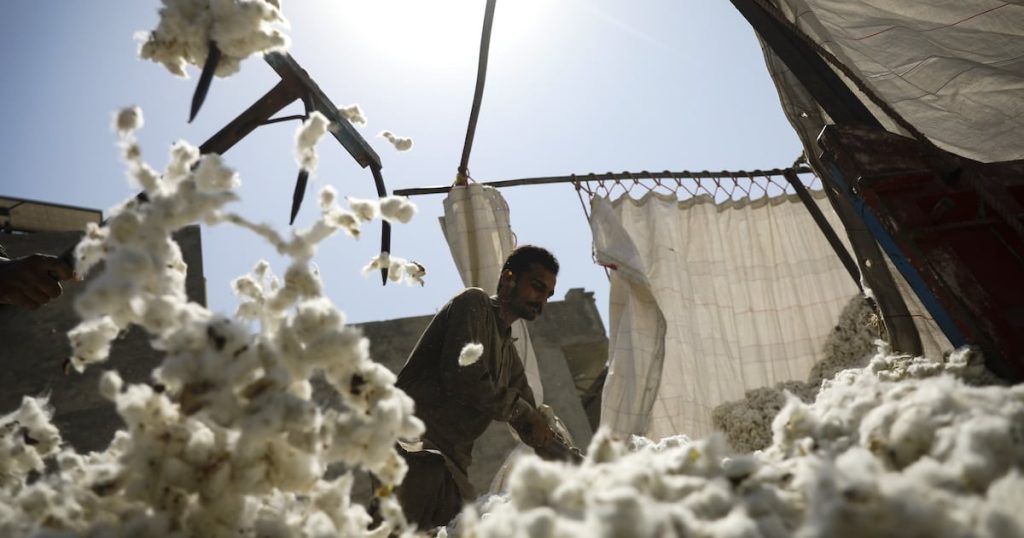Zara-owner Inditex is following through on a plan to ditch the fashion industry’s most widely used sustainable cotton scheme, as it aims to deliver on a promise to consumers and the investor community that it will reduce the environmental impact of its raw materials by the end of the decade.
Cotton dominates the material mix of the industry’s biggest publicly traded fast-fashion brands, like Zara and H&M, and is a core component of staple products like jeans and T-shirts. But depending on how it’s farmed, cotton can be a polluting crop, guzzling hefty doses of toxic pesticides and fertilisers, destroying soil health and deforesting protected land. The commodity’s complex and opaque supply chains have also been linked to serious human rights abuses, including child and forced labour.
For most big brands, cotton certified under the Better Cotton standard plays a central role in efforts to address these risks. But in line with a long-term strategy announced in 2023, and following a major scandal last year, Inditex has indicated that cotton certified under the programme no longer qualifies as lower-impact in its book.

Though other large fashion companies have not indicated they are making similar switches, it’s a blow because Inditex is such a major player in the industry. Cotton is its most widely used material, accounting for nearly half of the fashion giant’s total fibre mix. Last year, the company used nearly 300,000 tonnes of the material, roughly equivalent to the total production of the West African nation of Benin — the world’s 10th-largest cotton producing country.
What is Better Cotton and why is Inditex dropping it?
The 20-year-old initiative was set up by an international group of environmental organisations, brands and trade groups with the aim of rapidly increasing volumes of cotton produced with lower environmental impact and higher social standards. Though its critics argue the scheme is too lax, it has been remarkably successful in reaching scale. So much so, that roughly a fifth of the world’s cotton production is now certified under the programme and it’s become a go-to for brands from H&M to Louis Vuitton.
Until recently, Inditex, the world’s biggest fast fashion brand, also relied heavily on the scheme to back up claims it was sourcing more sustainable cotton. But in its latest annual report, published earlier this month, the company dropped cotton certified under the programme from its list of materials considered lower impact. Though the company is still using Better Cotton, it substantially rebalanced its sourcing last year to prioritise organic and recycled raw materials.
The move is part of a previously announced strategy to shift Inditex’s material mix, the company says. It also comes as Better Cotton has been scrambling to address controversy, after an investigation last year alleged farms certified under its standards were linked to large-scale deforestation, land grabbing and violent harassment of local communities in Brazil. This “tainted” cotton was also finding its way into the supply chains of major brands like Zara and H&M, according to the investigation.
Better Cotton said a third-party audit found no evidence its standards had been breached, but nonetheless committed to address weaknesses and risks revealed by the controversy. Inditex was particularly critical, writing the standard body a searing letter that demanded it tighten up its certification process and threatened to consider alternative initiatives if it didn’t take sufficient action.
Better Cotton said it is making efforts to further enhance its standards. “We respect that companies may adapt their sourcing practices to meet their needs, as we continue to innovate,” it said in an email.
Where does Zara buy its cotton now?
Even before the scandal, Inditex had indicated that it planned to move away from the scheme. When it updated its sustainability strategy in 2023, the company set a target to almost exclusively source organic, regenerative, recycled and next-generation fibres by the end of the decade.

At the time, Better Cotton accounted for three quarters of the fashion giant’s cotton supply, but over the last year that’s dramatically shifted. In 2024, nearly half of the cotton Inditex sourced was certified organic, up from 8 percent in 2023. Recycled cotton and cotton in conversion (raw material sourced from fields in the process of shifting from conventional to organic farming practices) also substantially increased their share to make up roughly a quarter of the company’s cotton supply. Inditex confirmed it continues to use Better Cotton, though it no longer discloses how much.
Is organic cotton any better?
Industry insiders say the challenges in establishing ethical and responsible cotton supply chains go well beyond any one certification scheme. The commodity is bought and sold through complex trading networks with bales from different farms and regions routinely mixed together. Most certification schemes don’t offer brands assurance over environmental and social conditions back to the farm level.
“Most brands are under increased pressure and scrutiny to prove the origin, providence and verified impact of their supply chains and materials in a manner that today most are not capable of doing,” said Crispin Argento, founder of The Sourcery, a sourcing platform that helps brands procure cotton with a better environmental, commercial and social impact.

Organic cotton in particular has been beset by allegations of fraud. Supply remains extremely limited at just 2 percent of the global market and increasing it isn’t a simple matter. It takes several years to convert a field that has been farmed using chemical pesticides and synthetic fertilisers to meet organic standards, which means there isn’t a lever to swiftly ratchet up supply if demand increases.
In India, the largest source of organic cotton, most of the seed on the market is genetically modified, which isn’t allowed in organic farming. “Add in declining yields, the impact of climate change, and some farmers moving away from cotton altogether, and it’s hard to imagine large volumes of organic cotton appearing overnight without raising some questions,” said sustainability strategist Marzia Lanfranchi. “When companies report a sudden surge in organic cotton use, it’s fair to ask: Where is this cotton coming from? How was it grown? Who grew it?”

Inditex said it has spent a decade on work to support farmers and boost its access to supply of organic cotton, making substantial investments to further its ambitions. Its sourcing practices for the material rest on robust systems that ensure compliance with certification requirements, it said, adding that it is working with standard owners and certification bodies to further strengthen controls.
In 2023, 560,000 tonnes of organic cotton were produced globally, according to Textile Exchange, a nonprofit that works with farmers and brands to promote lower-impact raw materials. Inditex’s purchases amounted to fully a fifth of that volume last year, according to the company’s data.








